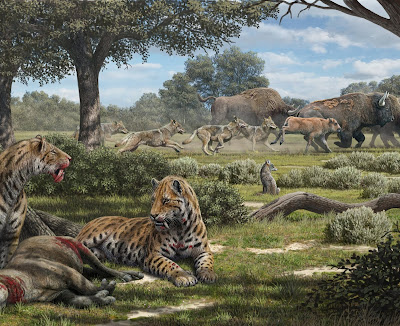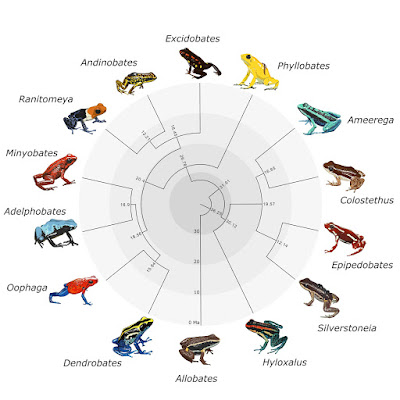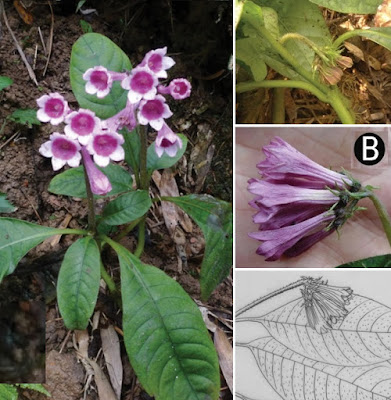[Most Recent Entries] [Calendar View]
Tuesday, August 6th, 2019
| Time | Event | ||||
| 3:09a | [PaleoMammalogy • 2019] Causes and Consequences of Pleistocene Megafaunal Extinctions as Revealed from Rancho La Brea Mammals
Highlights: • Sabertooth cats and dire wolves were not in competition for similar prey • Sabertooth cats scavenged more intensively during cooler intervals • Coyote diets were substantially affected by the extinction of megafauna • Rancho La Brea fossils reveal that diets of carnivorans are not always conserved Summary The fossils preserved in the Rancho La Brea “tar” seeps in southern California span the past ∼50,000 years and provide a rare opportunity to assess the ecology of predators (e.g., the American lion, sabertooth cats, cougars, dire wolves, gray wolves, and coyotes), including clarifying the causes and consequences of the terminal Pleistocene extinction event. Here, a multi-proxy approach elucidates dietary responses of carnivorans to changing climates and megafaunal extinctions. Using sample sizes that are unavailable anywhere else in the world, including hundreds of carnivoran and herbivore specimens, we clarify the paleobiology of the extinct sabertooth cats and dire wolves—overturning the idea that they heavily competed for similar prey. Canids (especially the dire wolf) consumed prey from more open environments than felids, demonstrating minimal competition for prey throughout the latest Pleistocene and largely irrespective of changing climates, including just prior to their extinction. Coyotes experienced a dramatic shift in dietary behavior toward increased carcass utilization and the consumption of forest resources (prey and/or plant resources) after the terminal Pleistocene megafaunal extinction. Extant predators’ ability to effectively hunt smaller prey and/or utilize carcasses may have been a key to their survival, especially after a significant reduction in megafaunal prey resources. Collectively, these data suggest that dietary niches of carnivorans are not always static and can instead be substantially affected by the removal of top predators and abundant prey resources. Keywords: Canis, Carnivora, diet, dental microwear, mammals, paleoecology, Pleistocene, Rancho La Brea, Smilodon, stable isotopes
Larisa R.G. DeSantis, Jonathan M. Crites, Robert S. Feranec, Kena Fox-Dobbs, Aisling B. Farrell, John M. Harris, Gary T. Takeuchi and Thure E. Cerling. 2019. Causes and Consequences of Pleistocene Megafaunal Extinctions as Revealed from Rancho La Brea Mammals. Current Biology. DOI: 10.1016/j.cub.2019.06.059 Intense look at La Brea Tar Pits explains why we have coyotes, not saber-toothed cats phys.org/news/2019-08-intense-la-brea-ta Saber-tooth surprise: Fossils redraw picture of the fearsome big cat on.natgeo.com/2M29oUu via @NatGeoScience | ||||
| 1:54p | [Herpetology • 2019] Phylogenomic Reconstruction of the Neotropical Poison Frogs (Dendrobatidae) and Their Conservation
Abstract The evolutionary history of the Dendrobatidae, the charismatic Neotropical poison frog family, remains in flux, even after a half-century of intensive research. Understanding the evolutionary relationships between dendrobatid genera and the larger-order groups within Dendrobatidae is critical for making accurate assessments of all aspects of their biology and evolution. In this study, we provide the first phylogenomic reconstruction of Dendrobatidae with genome-wide nuclear markers known as ultraconserved elements. We performed sequence capture on 61 samples representing 33 species across 13 of the 16 dendrobatid genera, aiming for a broadly representative taxon sample. We compare topologies generated using maximum likelihood and coalescent methods and estimate divergence times using Bayesian methods. We find most of our dendrobatid tree to be consistent with previously published results based on mitochondrial and low-count nuclear data, with notable exceptions regarding the placement of Hyloxalinae and certain genera within Dendrobatinae. We also characterize how the evolutionary history and geographic distributions of the 285 poison frog species impact their conservation status. We hope that our phylogeny will serve as a backbone for future evolutionary studies and that our characterizations of conservation status inform conservation practices while highlighting taxa in need of further study. Keywords: UCE; phylogenetics; amphibians; Dendrobatidae; Aromobatidae; frogs; systematics Wilson X. Guillory, Morgan R. Muell, Kyle Summers and Jason L. Brown. 2019. Phylogenomic Reconstruction of the Neotropical Poison Frogs (Dendrobatidae) and Their Conservation. Diversity. 11(8) [the Special Issue Systematics and Conservation of Neotropical Amphibians and Reptiles]. DOI: 10.3390/d11080126 | ||||
| 2:18p | [Botany • 2019] Ophiorrhiza shiqianensis (Rubiaceae) • A New Species from Guizhou, China
Abstract A new species of the genus Ophiorrhiza L. (Rubiaceae), Ophiorrhiza shiqianensis L.D.Duan & Yun Lin, is described, illustrated and photographed from Shiqian County, Guizhou Province, South-western China. This species was found growing at the side of streams in evergreen broad-leaved forests in mountains at elevations of 960–1100 m. The new species is morphologically similar to Ophiorrhiza hunanica H.S.Lo, but differs from the latter by the glabrous, glabrescent or pilose stems, the 5–10 cm long subterranean stem internodes, the glabrous or pilose petioles, the 3–5 mm long stipules, the purple corolla lobes, the ca. 12 mm long style and included stigmas in long-styled flowers and the 3–4 × 8–10 mm, glabrous or glabrescent capsules. Keywords: Distyly, morphology, new taxon, taxonomy Ophiorrhiza shiqianensis L.D.Duan & Yun Lin, sp. nov. Diagnosis: Similar to Ophiorrhiza hunanica H. S. Lo based on stems, leaves and capsules; differing from it by the stems which are glabrous, glabrescent or pilose, the 5–10 cm long subterranean stem internodes, the glabrous or pilose petioles, the 3–5 mm long stipules, the purple corolla tube and lobes, the ca. 12 mm long styles and the included stigmas in long-styled flowers, the 3–4 mm × 8–10 mm, glabrous or glabrescent capsules [vs. stems densely villose, subterranean stem internodes 1–2 cm long, petioles villose, stipules 5–15 mm long, corolla tube purple and corolla lobes white, style 15–17 mm long and stigmas exserted in long-styled flowers, capsules 5–6 mm × 10–12 mm, densely villose in Ophiorrhiza hunanica (Figs 3, 4F)]. Distribution: Ophiorrhiza shiqianensis is only known from two localities in Shiqian County, northeast Guizhou Province, southwest China, notably: Fudingshan Nature Reserve, Pingshan Town and Nishan Village, Ganxi Town. Etymology: Ophiorrhiza shiqianensis is named after its type locality, Shiqian County, northeast Guizhou Province, southwest China. Lin-Dong Duan, Yun Lin and Zhen Lu. 2019. Ophiorrhiza shiqianensis (Rubiaceae), A New Species from Guizhou, China. PhytoKeys. 121: 43-51. DOI: 10.3897/phytokeys.121.30570 |
| << Previous Day |
2019/08/06 [Calendar] |
Next Day >> |











